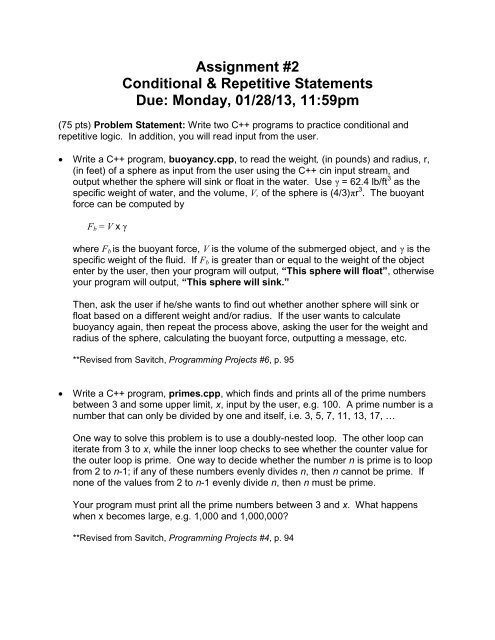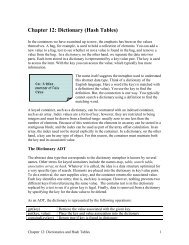Calculate Buoyant Force and Primes Numbers - Classes
Calculate Buoyant Force and Primes Numbers - Classes
Calculate Buoyant Force and Primes Numbers - Classes
Create successful ePaper yourself
Turn your PDF publications into a flip-book with our unique Google optimized e-Paper software.
Assignment #2<br />
Conditional & Repetitive Statements<br />
Due: Monday, 01/28/13, 11:59pm<br />
(75 pts) Problem Statement: Write two C++ programs to practice conditional <strong>and</strong><br />
repetitive logic. In addition, you will read input from the user.<br />
Write a C++ program, buoyancy.cpp, to read the weight, (in pounds) <strong>and</strong> radius, r,<br />
(in feet) of a sphere as input from the user using the C++ cin input stream, <strong>and</strong><br />
output whether the sphere will sink or float in the water. Use γ = 62.4 lb/ft 3 as the<br />
specific weight of water, <strong>and</strong> the volume, V, of the sphere is (4/3)πr 3 . The buoyant<br />
force can be computed by<br />
F b = V x γ<br />
where F b is the buoyant force, V is the volume of the submerged object, <strong>and</strong> γ is the<br />
specific weight of the fluid. If F b is greater than or equal to the weight of the object<br />
enter by the user, then your program will output, “This sphere will float”, otherwise<br />
your program will output, “This sphere will sink.”<br />
Then, ask the user if he/she wants to find out whether another sphere will sink or<br />
float based on a different weight <strong>and</strong>/or radius. If the user wants to calculate<br />
buoyancy again, then repeat the process above, asking the user for the weight <strong>and</strong><br />
radius of the sphere, calculating the buoyant force, outputting a message, etc.<br />
**Revised from Savitch, Programming Projects #6, p. 95<br />
<br />
Write a C++ program, primes.cpp, which finds <strong>and</strong> prints all of the prime numbers<br />
between 3 <strong>and</strong> some upper limit, x, input by the user, e.g. 100. A prime number is a<br />
number that can only be divided by one <strong>and</strong> itself, i.e. 3, 5, 7, 11, 13, 17, …<br />
One way to solve this problem is to use a doubly-nested loop. The other loop can<br />
iterate from 3 to x, while the inner loop checks to see whether the counter value for<br />
the outer loop is prime. One way to decide whether the number n is prime is to loop<br />
from 2 to n-1; if any of these numbers evenly divides n, then n cannot be prime. If<br />
none of the values from 2 to n-1 evenly divide n, then n must be prime.<br />
Your program must print all the prime numbers between 3 <strong>and</strong> x. What happens<br />
when x becomes large, e.g. 1,000 <strong>and</strong> 1,000,000?<br />
**Revised from Savitch, Programming Projects #4, p. 94
(10 pts) In your implementations, make sure that you include a program<br />
header/description in your program, in addition to proper indentation/spacing <strong>and</strong> other<br />
comments! Read the class style guideline for more information:<br />
http://classes.engr.oregonstate.edu/eecs/winter2013/cs161-001/161_style_guideline.pdf<br />
You are graded on having a header, proper comments, <strong>and</strong> readable code with<br />
indentation <strong>and</strong> vertical spacing that is CONSISTENT throughout your program. DO<br />
NOT align your entire program on the left side. This will cause you to automatically lose<br />
the full 10 points. In addition, do not forget your program header!!!<br />
(15 pts) You are required to turn in a written document (as a pdf) addressing Polya’s<br />
steps to solving a problem for both problems above, with step 3 being the C++<br />
programs you write to carry out/implement your plans. With this said, your written<br />
document must include these three sections:<br />
Underst<strong>and</strong>ing the Problem<br />
In your own words, explain what YOU think the problem is asking you to do. In<br />
this section, document your uncertainties about the problem <strong>and</strong> anything else<br />
that you feel was unclear or vague. This is to ensure that YOUR underst<strong>and</strong>ing<br />
matches MY underst<strong>and</strong>ing of the problem<br />
Devising a Plan/Design<br />
At a minimum, provide an algorithm/pseudo code you designed to help solve the<br />
problem. In addition, include pictures/flow charts you used to help you devise<br />
your plan, as well as any other design decisions you made such as how to<br />
manage your time, how to decompose the problem, where to start first, etc. You<br />
can scan any h<strong>and</strong>written work <strong>and</strong> attach it to the document as needed.<br />
Looking Back/Self-Reflection<br />
Report any checking/self-reflection you did while solving the problem. For<br />
instance, how did you make sense of the output from the implementation? This<br />
includes things such as using a calculator to make sure the output is correct,<br />
testing to make sure your code executes correctly <strong>and</strong> behaves the way you<br />
expect under specific circumstances, using external sources of information such<br />
as the internet to make sense of the results, etc. Also, include a statement about<br />
what you learned from the assignment.<br />
Electronically submit your two C++, buoyancy.cpp <strong>and</strong> primes.cpp, program files<br />
<strong>and</strong> your design document, .pdf, by the assignment due date, using TEACH.

















